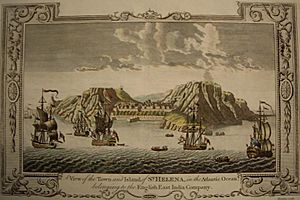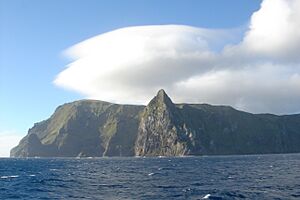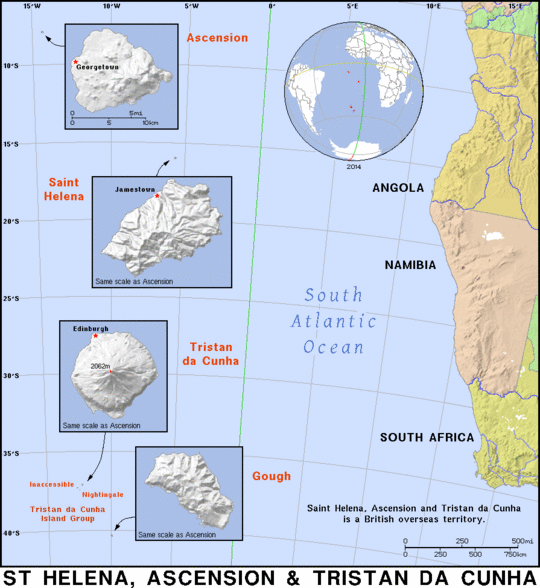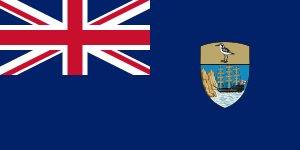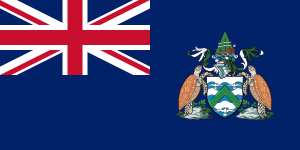Saint Helena, Ascension and Tristan da Cunha facts for kids
Quick facts for kids
Saint Helena, Ascension and Tristan da Cunha
|
||
|---|---|---|
|
Overseas territory of the United Kingdom
|
||
|
||
| Anthem: "God Save the King" | ||
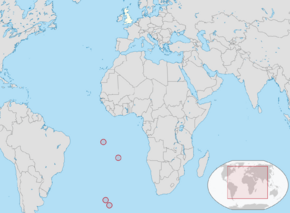
Location of Saint Helena, Ascension and Tristan da Cunha (circled in red). Ascension is the northernmost circle, Tristan da Cunha is the two adjacent circles in the far south, and Saint Helena is in the middle. The United Kingdom is located at the top in white.
|
||
| Sovereign state | ||
| Saint Helena colonial charter | 1657 | |
| Crown colony | 22 April 1834 | |
| Ascension added | 12 September 1922 | |
| Tristan da Cunha added | 12 January 1938 | |
| Current constitution | 1 September 2009 | |
| Capital | Jamestown 15°56′S 05°43′W / 15.933°S 5.717°W |
|
| Largest city | Half Tree Hollow 15°56′0″S 5°43′12″W / 15.93333°S 5.72000°W |
|
| Official languages | English | |
| Government | Devolved self-governing dependencies under a constitutional monarchy | |
|
• Monarch
|
Charles III | |
|
• Governor of Saint Helena, Ascension and Tristan da Cunha
|
Nigel Phillips | |
|
• Administrator of Ascension
|
Simon Minshull | |
|
• Administrator of
Tristan da Cunha |
Philip Kendall | |
|
• Chief Minister of Saint Helena
|
Julie Thomas | |
| Area | ||
|
• Total
|
394 km2 (152 sq mi) | |
| Highest elevation | 2,062 m (6,765 ft) | |
| Population | ||
|
• 2016 census
|
5,633 (not ranked) | |
|
• Density
|
13.4/km2 (34.7/sq mi) (not ranked) | |
| GDP (nominal) | estimate | |
|
• Total
|
USD 43,000,000 | |
| Currency | Saint Helena pound (£) (SHP) (Saint Helena and Ascension) Pound sterling (£) (GBP) (Tristan da Cunha) |
|
| Time zone | UTC±00:00 (GMT) | |
| Date format | dd/mm/yyyy | |
| Driving side | left | |
| Calling code | +290 (Saint Helena and Tristan da Cunha) +247 (Ascension) |
|
| UK postcode |
STHL 1ZZ (Saint Helena)
ASCN 1ZZ (Ascension) TDCU 1ZZ (Tristan da Cunha) |
|
| ISO 3166 code | SH | |
| Internet TLD | ||
Saint Helena, Ascension and Tristan da Cunha is a British Overseas Territory. It is located in the South Atlantic. This territory is made up of three main islands: Saint Helena, Ascension Island, and the group of islands called Tristan da Cunha. This group also includes Gough Island.
Before 2009, the territory was called "Saint Helena and Dependencies". On September 1, 2009, a new rule book (constitution) was put in place. This rule book gave all three islands equal importance. They are now grouped together under the British Crown.
Contents
Island History
The islands of Saint Helena, Ascension Island, and Tristan da Cunha were all formed by volcanoes. Portuguese explorers discovered them between 1502 and 1504. At first, they were separate colonies of the English Crown.
Portuguese Discovery
The Portuguese explorers found Saint Helena empty of people. It had many trees and fresh water. They brought animals like livestock, fruit trees, and vegetables to the island. They also built a small church and some houses.
The Portuguese did not stay permanently. But the island became a very important stop for ships traveling home from Asia. They could get food and meet up there. An English explorer named Francis Drake likely visited the island around 1580. Other English explorers followed.
When more people knew about Saint Helena's location, English warships started waiting there. They would attack Portuguese ships returning from India. The Dutch also visited the island often for their trade with the Far East. They claimed the island in 1633. However, they did not settle there and mostly left it by 1651. They preferred their colony at the Cape of Good Hope.
English Colonization
In 1657, the English East India Company was given permission to govern Saint Helena by Oliver Cromwell. The next year, the Company decided to build defenses and settle the island with farmers. The first governor arrived in 1659. This is why Saint Helena says it is Britain's second oldest colony, after Bermuda.
A fort was built, along with several houses. After the British monarchy was brought back in 1660, the East India Company received a special Royal Charter. This gave them the only right to protect and settle the island. The fort was renamed James Fort, and the town became Jamestown. These names honored the Duke of York, who later became King James II of England and VII of Scotland.
The Kingdom of England became part of the new Kingdom of Great Britain in 1707. Then it became the United Kingdom in 1801. The British Empire grew very powerful around the world. The island of Saint Helena became famous as the place where Napoleon Bonaparte was sent into exile. He stayed on the island from October 1815 until he died in May 1821.
Saint Helena became a British crown colony in 1834. This happened because of the Government of India Act 1833. Ascension Island was not lived on, but the Royal Navy took control of it on October 22, 1815. This was soon after Napoleon was sent away. Ascension became important as a place for ships to refuel with coal.
For similar reasons, Tristan da Cunha was added as a part of the Cape Colony (British South Africa) on August 14, 1816. This was at the end of the Napoleonic Wars. Before this, Tristan da Cunha was briefly settled by an American group. They called the territory the Islands of Refreshment.
The three colonies started to join together on September 12, 1922. On that date, Ascension Island became a part of Saint Helena. Tristan da Cunha, which still has a small population today, joined on January 12, 1938. These three island groups shared this connection until September 1, 2009. At that time, Ascension and Tristan da Cunha were given equal status with Saint Helena. The territory's name changed from "Saint Helena and Dependencies" to "Saint Helena, Ascension and Tristan da Cunha".
World War II and Military Presence
During World War II, Saint Helena and Ascension Island were important for the Allies. They used the islands to base planes and ships. These forces patrolled the Atlantic Ocean to fight against enemy ships and submarines.
At first, long-range flying boats were used. Later, airfields were built to support land-based planes. These planes helped with the important job of finding and fighting submarines.
Today, the United Kingdom and the United States still work together at the airfield (RAF Ascension Island) on Ascension. This base is also used for space communication and navigation. It has one of only four GPS satellite ground antennas in the world.
Geography
These territories are spread out over a huge area of the South Atlantic Ocean. The northernmost island, Ascension, is at 7° 56′ S of the equator. The southernmost island, Gough Island, is at 40° 19′ S. The Tropic of Capricorn is located between Saint Helena and Tristan da Cunha.
The distance between the northern tip of Ascension Island and the southern tip of Gough Island is 2,263 miles (3,642 km). This is like the distance between London and the Dead Sea. All three territories are in the Western Hemisphere. They all share the same time zone, which is Greenwich Mean Time. They do not use Daylight saving time.
All three territories were formed by volcanic activity. However, only the Tristan da Cunha group of islands has active volcanoes right now.
The highest point in the territories is Queen Mary's Peak. It is on the island of Tristan da Cunha. This peak is 2,062 metres (6,765 ft) above sea level. It is known as an ultra prominent peak.
Climate
Because the territories stretch over 3,600 km (2,200 mi) from north to south, they have different climates. Ascension has a warm, dry climate. Temperatures there stay above 20 °C (68 °F) all year. Saint Helena has a more moderate climate, and it is dry near the coasts.
Tristan da Cunha is closer to the Antarctic Circle. It is much cooler and wetter. The uninhabited southernmost Gough Island is even wetter and has freezing temperatures in winter.
Territorial Waters
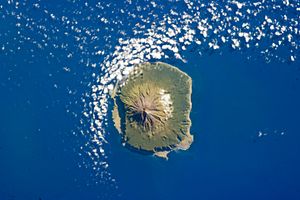
The territorial waters around the islands go out 12 nautical miles (22 km) from their coasts. The Exclusive Economic Zones (EEZs) go out 200 nautical miles (370 km) from the islands' coasts. These three EEZs do not touch each other or the EEZs of any other country.
The territories have the largest EEZ of all British overseas territories. It is even larger than the United Kingdom's own EEZ. If it were ranked among countries, it would be 21st in size. There are no arguments with other countries about these islands or their EEZs.
| Part | km2 | sq mi |
|---|---|---|
| Ascension Island | 441,658 | 170,525 |
| Saint Helena | 444,916 | 171,783 |
| Tristan da Cunha | 754,720 | 291,400 |
| Total | 1,641,294 | 633,708 |
Government and Administration
Template:Politics of Saint Helena, Ascension and Tristan da Cunha
Each part of Saint Helena, Ascension and Tristan da Cunha has its own government council. The Governor of the territory leads the Saint Helena Legislative Council. An Administrator leads the Island Council on Ascension Island. Another Administrator leads the Island Council on Tristan da Cunha.
| Administrative area |
Area km2 |
Area mi2 |
Population | Administrative centre |
|---|---|---|---|---|
| Saint Helena | 122 | 47 | 4,534 | Jamestown |
| Ascension Island | 88 | 34 | 806 | Georgetown |
| Tristan da Cunha | 207 | 71 | 293 | Edinburgh of the Seven Seas |
| Main island | 98 | 39 | 293 | |
| Inaccessible Island | 14 | 5 | 0 | |
| Nightingale Islands | 3.4 | 1.3 | 0 | |
| Gough Island | 91 | 35 | 0 | |
| Total | 394 | 152 | 5,633 | Jamestown |
The island of Saint Helena is also divided into eight smaller districts.
Constitution and Leadership

The St Helena, Ascension and Tristan da Cunha Constitution Order 2009 is the main rule book for the territory. It started on September 1, 2009. This rule book made Ascension Island and Tristan da Cunha equal parts of the territory, not just dependencies of Saint Helena.
Each part has its own government. However, the Governor of Saint Helena is also the Governor for Ascension and Tristan da Cunha. Because the islands are far apart, Ascension and Tristan da Cunha each have an Administrator. This person represents the Governor when the Governor is not on the island. The constitution also includes important "fundamental rights and freedoms" for everyone.
| Part | Crown representative | Council |
|---|---|---|
| Saint Helena | Governor of Saint Helena | Legislative Council of Saint Helena |
| Ascension Island | Governor of Ascension Represented by the Administrator of Ascension |
Ascension Island Council |
| Tristan da Cunha | Governor of Tristan da Cunha Represented by the Administrator of Tristan da Cunha |
Tristan da Cunha Island Council |
Saint Helena also has an Executive Council. The Governor of Saint Helena represents the British monarch. The three territories share the same chief legal officer (Attorney General). They also share the same highest court, the Supreme Court, and a Court of Appeal.
Police and Defence
The Royal Saint Helena Police Service is in charge of keeping order on the islands. The United Kingdom is responsible for the defense of the territories. There are no military forces stationed on Saint Helena or Tristan da Cunha. The Royal Air Force has a base on Ascension Island. This base is part of the British military forces in the South Atlantic.
Education
Saint Helena has several schools, including Prince Andrew School. Ascension Island has Two Boats School. Tristan da Cunha also has its own school, called St. Mary's School.
Religion
Most people on Saint Helena are part of the Anglican Communion. They belong to the Diocese of St Helena, which includes Ascension Island and has its own bishop.
Catholics are served by the Missio sui iuris of Saint Helena, Ascension and Tristan da Cunha. This group is connected to the Apostolic Prefecture of the Falkland Islands.
Currency
In 1821, a special copper halfpenny was made for use in Saint Helena. This coin was used along with British money.
Saint Helena used British currency until 1976. Then, it started to print its own banknotes, which had the same value as British pounds. In 1984, the territory also started to make its own coins for Saint Helena and Ascension Island. These coins were the same size as UK coins.
Like British coins, Queen Elizabeth II is on one side. But the other side has different designs that show things from the territory. The coins say "Saint Helena • Ascension". The banknotes only say "Government of St. Helena". Special collector coins are made separately for each island. They say either "St. Helena" or "Ascension Island".
The Saint Helena pound is used on Ascension Island. However, it is not used in Tristan da Cunha. In Tristan da Cunha, people use UK currency.
The Currency Commissioners, part of the Government of Saint Helena, issue the Saint Helena pound banknotes and coins. There is no central bank. The currency's value is fixed to the pound sterling, which is controlled by the Bank of England in London. The Bank of Saint Helena is the only bank in the territory. It has branches in Jamestown on Saint Helena and Georgetown on Ascension Island. People on Tristan da Cunha can also use its services.
Communications
Telecommunications
Sure South Atlantic provides phone and internet services in the territories. Saint Helena has the international calling code +290. Since 2006, Tristan da Cunha shares this code. Since 2013, phone numbers have five digits. Landline numbers start with "2", and mobile numbers start with "5" or "6".
Ascension Island has a separate country code, +247. It also has five-digit numbers, which changed in 2015. Ascension Island also had a large radio station for sending shortwave broadcasts to Africa and South America.
Ascension Island, Tristan da Cunha, and Saint Helena all print their own postage stamps. Selling these stamps brings in a lot of money. Each of the three territories has its own Royal Mail postal code:
- Ascension Island: ASCN 1ZZ
- Saint Helena: STHL 1ZZ
- Tristan da Cunha: TDCU 1ZZ
Flags
The Flag of the United Kingdom is used for all official purposes. Each of the three territories also has its own flag for official use. Between 2002 and 2013, Saint Helena and Tristan da Cunha had their own flags. Ascension Island used the Union Flag. Before 2002, Tristan da Cunha used the flag of Saint Helena for all official purposes.
Saint Helena Flag
The flag of Saint Helena was adopted on October 4, 1984. It is a modified Blue Ensign. This means it has a blue background with the Union Jack in the top left corner. The shield from the coat of arms of Saint Helena is in the middle of the right half. The shield shows a rocky coastline and a three-masted sailing ship. On top of the shield is a Saint Helena plover, also known as a wirebird. The bird on the flag was updated in 2018 to look more realistic.
Ascension Island Flag
The flag of Ascension Island was adopted on May 11, 2013. This flag is also a blue ensign design. It has the coat of arms of Ascension Island on it. Before this flag was adopted, the island used the Union Flag of the United Kingdom for official purposes.
Tristan da Cunha Flag
The flag of Tristan da Cunha was adopted on October 20, 2002. This was announced by the Governor of Saint Helena. It was approved by Queen Elizabeth II. Before this, Tristan da Cunha used the flag of Saint Helena because it was a dependency of Saint Helena.
This flag is also a blue ensign design. It has the coat of arms of Tristan da Cunha on it. The coat of arms shows a Tristan longboat above a Naval Crown. In the middle is a shield with four yellow-nosed albatrosses. On each side of the shield are two Tristan rock lobsters. Below this is a ribbon with the territory's motto: Our faith is our strength.
Transport
Maritime Transport
Each of the three main islands has a harbor or small port. These are located in the main towns: Georgetown, Jamestown, and Edinburgh. Saint Helena also has a 118-meter-long permanent dock in Rupert's Bay. This dock was built as part of the airport project. It is used for large cargo, containers, and general goods, as well as for passengers.
Airports
Saint Helena Airport had its first regular commercial flight on October 14, 2017. Commercial flights are operated by Airlink using an Embraer E190 plane. They fly from OR Tambo Airport in Johannesburg every Saturday. The plane returns the same day, or on Sunday if it also flies to Ascension Island.
Commercial flights between Saint Helena and Ascension Island happen on the second Saturday of each month. The plane returns to Saint Helena on Sunday, then continues to Johannesburg.
There is a military airfield on Ascension Island (RAF Ascension Island). However, problems with the runway caused most flights to be cancelled in April 2017. Only essential flights and medical emergencies were allowed. Regular RAF flights used to connect Ascension with RAF Brize Norton in the UK and RAF Mount Pleasant in the Falkland Islands. This transport link was called the South Atlantic Air Bridge. These flights mainly carried military personnel. However, the RAF also allowed paying civilians to use them.
Ascension Island is also used by the US military. They supply their base using the MV Ascension ship. The island was also a planned emergency landing site for the Space Shuttle program.
The islands of Tristan da Cunha can only be reached by sea. They do not have an airport.
| Location | ICAO | IATA | Airport name | Runway length |
|---|---|---|---|---|
| Ascension Island | FHAW | ASI | RAF Ascension Island | 3,054 metres (10,020 ft) |
| Saint Helena | FHSH | HLE | Saint Helena Airport | 1,950 metres (6,400 ft) |
Vehicular Traffic
Saint Helena has 138 kilometres (86 mi) of roads. Of these, 118 kilometres (73 mi) are paved, and 20 kilometres (12 mi) are unpaved. Tristan da Cunha has about 10 kilometres (6 mi) of paved roads. Ascension has around 40 kilometres (25 mi) of paved roads.
Each island has its own system for vehicle license plates. Traffic drives on the left in all three territories, just like in the United Kingdom. Two nearby countries, South Africa and Namibia, also drive on the left.
See also
 In Spanish: Santa Elena, Ascensión y Tristán de Acuña para niños
In Spanish: Santa Elena, Ascensión y Tristán de Acuña para niños



